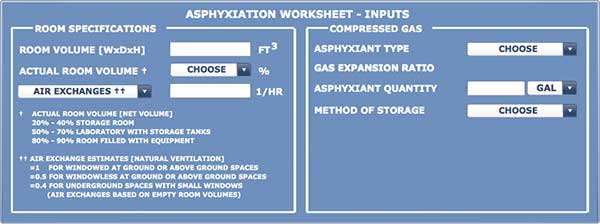Assessing Asphyxiation Risks
 The risk of asphyxiation, a condition of insufficient supply of oxygen to the body, is difficult to assess because of many factors that can contribute to an oxygen deficiency. However, these factors can be measured and used to calculate the risks that can lead to the hazardous conditions that would result in potential asphyxiation. The results can be used to make decisions about the installation, storage, and use of compressed gases as prescribed by state and local fire and building codes.
The risk of asphyxiation, a condition of insufficient supply of oxygen to the body, is difficult to assess because of many factors that can contribute to an oxygen deficiency. However, these factors can be measured and used to calculate the risks that can lead to the hazardous conditions that would result in potential asphyxiation. The results can be used to make decisions about the installation, storage, and use of compressed gases as prescribed by state and local fire and building codes.
The risk of asphyxiation is very real to occupants of a building, as well as first responders when entering a building. Many gases that are considered asphyxiant are ‘silent hazards’, hazards that you do not see, hear or smell. Additionally people exposed to asphyxiant gases may start feeling disoriented before losing consciousness. The best prevention practice is to provide protection systems to warn occupants and prevent the oxygen depletion in the room.
Compressed gases used in laboratories or manufacturing buildings are typically stored in cylinders, gas tanks and dewars. These containers can be filled with various asphyxiant gases such as argon, carbon dioxide, helium, hydrogen, nitrogen, or neon. The release of these gases may be of concern to life safety depending on the quantity of gas released and ventilation provided. Often some form of leakage needs to be expected, especially if indoor tanks and dewars are used to contain these agents.
Catastrophic events such as spillage of partial or entire content of the vessel can cause life-threatening conditions – if appropriate decisions are not made upfront to control or reduce any hazardous conditions arising from spillage. Ultimately only proper ventilation of the spaces where compressed gases are used or stored can ensure sufficient oxygen concentrations. However, with the new requirements adopted in the Green Building Codes continuous ventilation may not be allowed or practical, depending on the room size and associated energy needs.
To this end oxygen sensors can be installed that provide early warning signs such as alarm occupants, as soon as the concentrations fall below acceptable levels. But these devices require frequent calibration and maintenance and the potential for device malfunction always exists. Multiple sensors in a room would be needed to avoid any pockets where sensors are not accessible, as well as to ensure continuity of the system, even if one sensor malfunctions. Then sensors alone are not recommended. In lieu of continuous ventilation and to satisfy the Green Building Code, multiple point oxygen sensors to provide early warning, as well as to initiate the mechanical exhaust system is recommended.
Effects of Oxygen Deprivation
In general the effects of low oxygen concentration are a factor of both the oxygen concentration of the space and the length of exposure. While individuals subjected to these asphyxiants may only notice mild physical changes, they can suddenly lose consciousness without warning. Below a range of oxygen concentrations are listed that estimate safe to unsafe conditions.
| % O2 CONCENTRATION | EFFECT |
|---|---|
| 19 - 21% | No Hazard |
| 16 - 19% | Increased breathing rates, accelerated heartbeat, and impaired thinking or coordination may occur at any form of exertion. |
| 10 - 16% | Increased breathing rates and accelerated heartbeat, decreased mental effectiveness, visual acuity, and muscular coordination may occur even at rest. |
| 6 - 10% | Nausea, vomiting, lethargic movements, loss of consciousness may occur |
| < 6% | Prolonged exposure will result in death |
Even situations with slight oxygen deficiencies (at or below 19 % of oxygen concentrations) may cause a momentary loss of coordination. This can lead quickly to a life-threatening event, if it occurs while the room occupant or first responder is performing a potentially dangerous activity, such as climbing a ladder, operating equipment, or handling hazardous substances.
Asphyxiation Wizard
An asphyxiation calculator has been prepared to help determine oxygen levels and asphyxiation hazards as defined by the health and safety professionals, which is also used by the Fire Codes. The inputs will determine the oxygen levels for a given asphyxiation scenario.
State and local fire codes (based on the international fire codes) prescribe a minimum ventilation rate of one cubic foot per minute per square foot of room or area space under consideration. Using the calculator, a given scenario can be reviewed against this code requirement and used to examine asphyxiation risks. Also calculated is the time required after an incident has occurred until oxygen concentrations reach minimum acceptable levels again based on natural or forced ventilation.
The asphyxiation calculator can be accessed here.






